5.01.2025
Blue Origin is expected to launch its 1st New Glenn rocket next week, but when?
The first launch of New Glenn could occur between Jan. 6 and Jan. 12, according to the FAA.
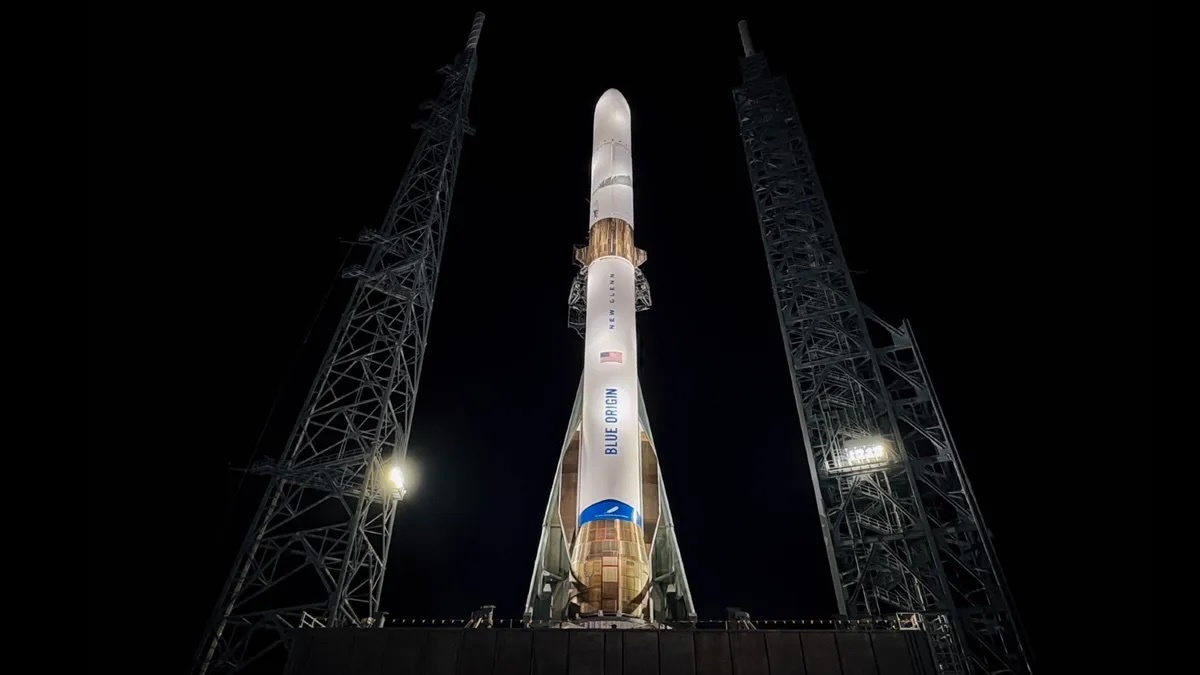
Blue Origin's first New Glenn heavy-lift rocket stands atop its Launch Complex 36 pad at Cape Canaveral Space Force Station in Florida ahead of its first test flight. (Image credit: Blue Origin)
Blue Origin, the private spaceflight company founded by billionaire Jeff Bezos, is on the cusp of launching into the big booster market with the debut of its New Glenn rocket next week, but exactly when the test flight will lift off is unclear.
After years of development — Jeff Bezos first announced the new rocket in 2016— Blue Origin is expected to launch its first New Glenn booster as early as Monday, Jan. 6, from a pad at Cape Canaveral Space Force Station in Florida. That's based on an FAA alert to pilots that states the opening of Blue Origin's New Glenn launch window. Liftoff would be at 1 a.m. EST (0600 GMT), according to that notice.
But Blue Origin has not publicly announced the specific launch date and time, only that is nearing the first launch of New Glenn after a succesful first stage hot-fire test on Dec. 27 at its pad, Space Launch Complex 36, in Cape Canaveral. The mission will be ambitious, testing a brand-new launch vehicle and attempting to land its first stage at sea.
"Well, all we have left to do is mate our encapsulated payload … and then LAUNCH!" Blue Origin CEO Dave Limp wrote on the social media site X.
"Next Stop launch," Bezos added.
According to the FAA, Blue Origin could launch New Glenn's first flight on Jan. 6 between 1 a.m. EST and 4:45 a.m. EST (0600-0945 GMT), a nearly 4-hour launch window, with backup opportunities daily through Jan. 12.
Blue Origin has named its first New Glenn booster "So You're Telling Me There’s a Chance" (according to Limp) and has already sent its landing drone ship, named Jacklyn after Bezos' mother, out to sea for a planned landing attempt in the Atlantic Ocean. Spaceflight photographer John Kraus shared images of the ship's departure on X.
New Glenn is a heavy-lift vehicle that, like SpaceX's Falcon and Starship rockets, is designed to be reusable, with its first stage returning to Earth for an ocean platform landing. Each New Glenn booster should be capable of up to 25 flights, Blue Origin has said.
The rocket sports a nearly 23-foot (7 meters) payload fairing that includes more than twice the volume of smaller, more commonly used 15-foot (5 m) fairings. The rocket is designed to carry payload of up to 13 metric tons to geostationary orbit and 45 metric tons to low Earth orbit.
"With twice the volume of smaller, five-meter class payload fairings, customers have more flexibility to package their payload in new ways," the company states in an overview.
For its first New Glenn flight, Blue Origin will not launch a payload at all. Instead, the mission, called NG-1, is carrying the Blue Ring Pathfinder, a 45,000-pound (20,411 kilograms) payload simulator version of the company's multi-use Blue Ring spacecraft to carry customer payloads.
"The demonstrator includes a communications array, power systems, and a flight computer affixed to a secondary payload adapter ring. The pathfinder will validate Blue Ring’s communications capabilities from orbit to ground," Blue Origin wrote in a payload overview. "The mission will also test its in-space telemetry, tracking and command hardware, and ground-based radiometric tracking that will be used on the future Blue Ring production space vehicle."
From launch to landing and mission end, Blue Origin's New Glenn rocket debut should last about six hours, the company has said. If successful, the mission could count towards one of Blue Origin's certification flights of New Glenn for the U.S. Space Force and National Security Space Launch program.
Blue Origin currently has New Glenn launch agreements in place with NASA (to launch the agency's ESCAPADE Mars probes), Amazon (to fly the company's Kuiper internet satellites), AST SpaceMobile (for space-to-phone communications service) and other commercial and government customers.
Quelle: SC
----
Update: 7.01.2025
.
The 'original' John Glenn gave his 'go' for Blue Origin's New Glenn
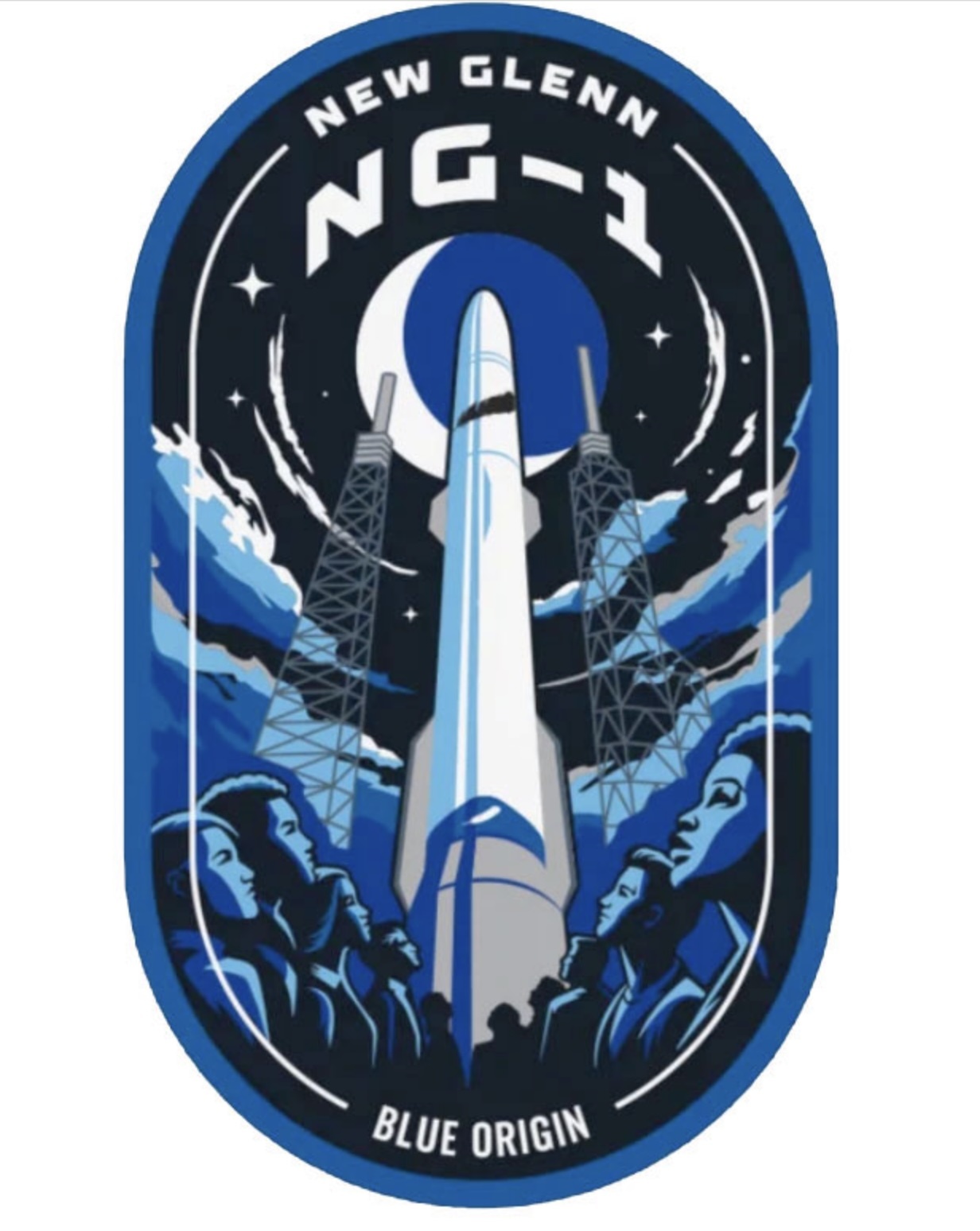
John Glenn's last correspondence before his death was to approve the use of his name for Blue Origin's first orbital-class rocket.
Nine years later, the "New Glenn" is ready for its inaugural launch. Though he did not live to see it come about, Glenn — the first American to orbit Earth in 1962 — hailed the booster's soon-to-be-demonstrated capabilities for what they could hold for the future of human spaceflight.
"As the original Glenn, I can tell you I see the day coming when people will board spacecraft the same way millions of us now board jetliners," wrote the Mercury astronaut and U.S. Senator in 2016, adding that he was "deeply touched" that the New Glenn would fly with his name.
One of the key factors to that future becoming a reality is the ability to "to get to space more often and more inexpensively," Glenn wrote, which is why the New Glenn was designed to "be reused over and over again."
At the time Glenn wrote his letter, the only commercial rocket to launch, land and be reused was Blue Origin's New Shepard sub-orbital booster. It was not until a month after Glenn's death that SpaceX followed with the first orbital launch of a "flight proven" Falcon 9 rocket.
Now, the New Glenn is ready to fly, and should all go to plan, fly again and again and again. Each rocket's first stage, which is powered by seven BE-4 engines, is rated for 25 flights. The first 322-foot-tall (98-meter) New Glenn, nicknamed "So You're Telling Me There's a Chance" after a line from the 1994 comedy "Dumb and Dumber," is set to launch from Space Launch Complex-36 at the Cape Canaveral Space Force Station in Florida on the NG-1 mission carrying a pathfinder for Blue Ring, Blue Origin's multi-mission space mobility platform.
Guarding the Glenn name
Glenn's letter, which he addressed to Blue Origin founder Jeff Bezos, was first made public on the day that he died, Dec. 8, 2016 — two weeks after he wrote it. Speaking at the Smithsonian American Ingenuity Awards ceremony, astronaut Mae Jemison read Glenn's words as part of a tribute to Bezos, who was among that year's honorees.
In January 2024, Trevor Brown, dean of the John Glenn College of Public Affairs at The Ohio State University in Columbus, recalled the same correspondence at an event honoring Glenn and the other astronauts who hailed from Ohio.
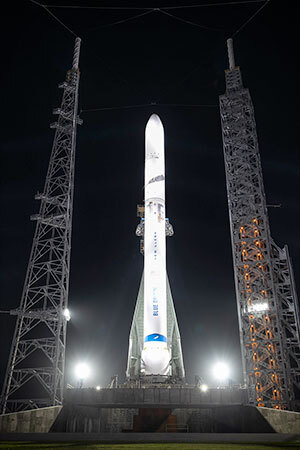
Blue Origin's New Glenn stands on Space Launch Complex-36 at Cape Canaveral Space Force Station in Florida ahead of its first launch. The rocket was named after the late astronaut and Senator John Glenn, the first American to fly into orbit in 1962. (Blue Origin)
"He knew the innovative power that the private sector could bring to the next phase of space exploration, which is perhaps why he was willing to lend his likeness to adorn Blue Origin's soon to be launched New Glenn rocket, something that he had ceded to right before he died," said Brown. "In fact, it is the last written communication from Senator Glenn is a letter to Jeff Bezos, essentially applauding or approving of the use of his name on this on this rocket."
Before his passing, Glenn entrusted the college to protect his legacy, assigning it control over of his name and likeness.
"Much over the course of history has been made of Senator Glenn resisting the use of his likeness for personal gain. [His daughter] Lynn Glenn, at his memorial, shared that — and this was upsetting to her — that he turned down a million dollars to have his face on the box of Wheaties. It offended his moral sensibilities and his inherent humbleness that someone should use their personal likeness for personal gain," Brown said.
"But at some point, when a person is as famous as a senator, your image is no longer your own and people and organizations can use your name and your likeness as it's in the public domain. But many people are kind enough to ask," he said.
Other than Blue Origin's new rocket, the "original Glenn" was the posthumous namesake for one other spacecraft, Northrop Grumman's (formerly Orbital ATK's) seventh Cygnus resupply vehicle bound servicing the International Space Station. The S.S. John Glenn lifted off in March 2017 and spent two months at the orbiting lab before being purposely destroyed during its reentry into Earth's atmosphere.
'New' crew
As Glenn mentioned in his letter to Bezos, the New Glenn is "the second generation" of Blue Origin's reusable rockets. The first, the New Shepard, has been flying crewed and cargo suborbital missions since 2015.
Like the New Glenn, which paired the company's first orbital rocket with the United States' first astronaut to fly into orbit, the New Shepard was named after Alan Shepard, the first American in space who flew on a 15-minute suborbital launch.
The "original" Shepard died in 1998, two years before Bezos founded Blue Origin, so was not aware of any plans to name a rocket after him. It is not known if Bezos sought permission from Shepard's family, but it is clear that at least one member had no issue with it — Laura Shepard Churchley, Shepard's eldest daughter, flew to space on New Shepard in 2021.
Blue Origin has also named a number of its business groups after astronauts, including: the New Chawla (named after the late Kalpana Chawla, the first immigrant Indian-American woman to become an astronaut); New Fisher (Anna Lee Fisher, the first mother to fly in space); New Gutierrez (Sidney Gutierrez, the first American-born Hispanic astronaut); New Herrington (John Herrington, the first enrolled member of a Native American tribe to fly in space); New Onizuka (Ellison Onizuka, the first Asian-American astronaut); and New Ride (Sally Ride, the first American woman in space and first-known LGBTQ+ person in space).
At the same time that Blue Origin announced the New Glenn in 2016, it also teased about an even larger, more powerful rocket, the "New Armstrong." Named after the late Neil Armstrong, the first person to step foot on the moon, the company has not said more about the name or its plans for the future booster.
Quelle: CS
----
Update: 11.01.2025
.
Blue Origin postpones New Glenn launch to Sunday, as high seas thwart booster landing try
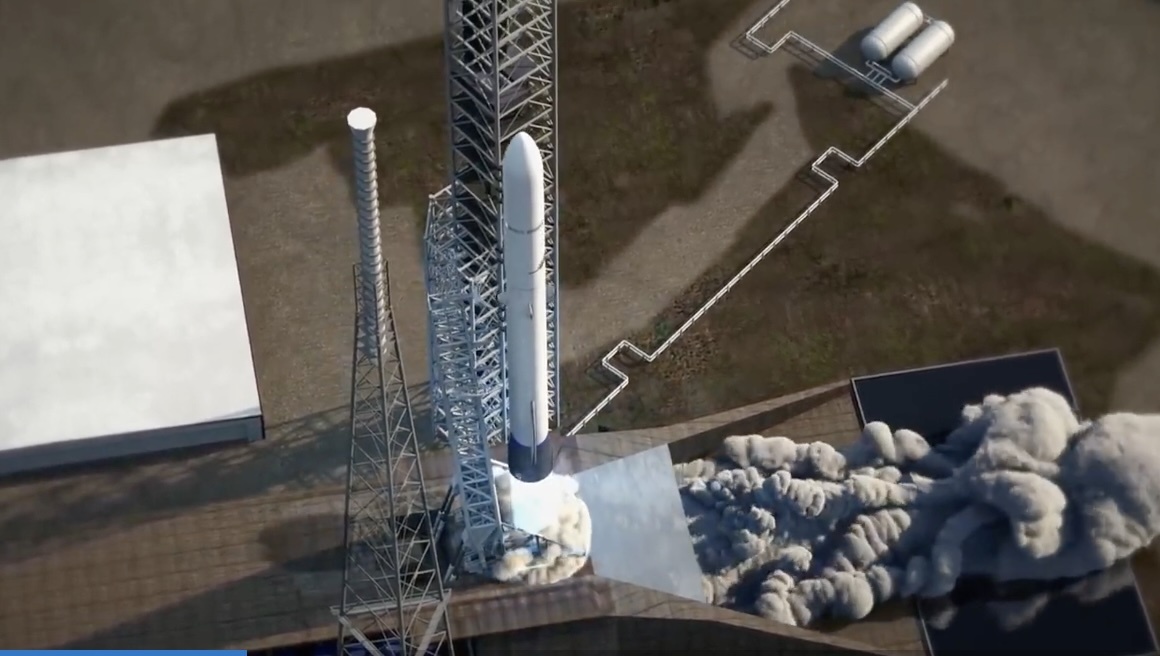
Citing unfavorable oceanic conditions, Blue Origin crews now hope to launch the first New Glenn two-stage rocket on its maiden missionearly Sunday morning from Cape Canaveral Space Force Station.
The launch was originally scheduled for a three-hour window opening at 1 a.m. Friday. But high seas in the Atlantic Ocean, where the booster will attempt to land on a drone ship, prompted a two-day delay.
Now, Amazon founder Jeff Bezos' private space company is targeting a similar three-hour launch window that extends from 1 a.m. to 4 a.m. Sunday. Measuring more than 320 feet high — taller than a football field — the heavy-lift New Glenn will take flight from Launch Complex 36, within easy eyeshot along the beach in Cape Canaveral and Cocoa Beach.
After soaring skyward along a due east trajectory, the white-and-blue rocket's first-stage booster will target landing aboard Blue Origin's drone ship Jacklyn — so named for Bezos' mother — out at sea. Blue Origin officials named the booster So You’re Telling Me There’s a Chance because "no one has landed a reusable booster on the first try," CEO Dave Limp said in a September tweet.
However, the Space Force's 45th Weather Squadron predicted a moderate-to-high risk of poor offshore landing weather during Friday's launch window — "significant seas heights will increase to the 11-to-12-foot range," the forecast said.
In the meantime Friday morning, look for a SpaceX Falcon 9 rocket to launch on another Starlink mission from NASA's Kennedy Space Center, a Federal Aviation Administration operations plan advisory shows. That launch window extends from 10:27 a.m. to 2:58 p.m.
Quelle: Florida Today
----
Update: 13.01.2025
.
New Glenn rocket is at the launch pad, waiting for calm seas to land
"Landing our booster offshore is ambitious—but we’re going for
COCOA BEACH, Fla.—As it so often does in the final days before the debut of a new rocket, it all comes down to weather. Accordingly, Blue Origin is only awaiting clear skies and fair seas for its massive New Glenn vehicle to lift off from Florida.
After the company completed integration of the rocket this week, and rolled the super heavy lift rocket to its launch site at Cape Canaveral, the focus turned toward the weather. Conditions at Cape Canaveral Space Force Base have been favorable during the early morning launch windows available to the rocket, but there have been complications offshore.
That's because Blue Origin aims to recover the first stage of the New Glenn rocket, and sea states in the Atlantic Ocean have been unsuitable for an initial attempt to catch the first stage booster on a drone ship. The company has already waived one launch attempt set for 1 am ET (06:00 UTC) on Friday, January 10.
Conditions have improved a bit since then, but on Saturday evening the company's launch officials canceled a second attempt planned for 1 am ET on Sunday. The new launch time is now 1 am ET on Monday, January 13, when better sea states are expected. There is a three-hour launch window. The company will provide a webcast of proceedings at this linkbeginning one hour before liftoff.
Seeking a nominal flight
According to a mission timeline shared by Blue Origin on Saturday, it will take several hours to fuel the New Glenn rocket. Second stage hydrogen loading will begin 4.5 hours before liftoff, followed by the booster stage and second stage liquid oxygen at 4 hours, and methane for the booster stage at 3.5 hours to go. Fueling should be complete about an hour before liftoff.
During a nominal mission the booster stage's seven BE-4 engines—which have previously performed well during two flights of United Launch Alliance's Vulcan rocket—will burn liquid methane for 3 minutes and 10 seconds. If all goes well with this booster stage after separation from the second stage, it will initiate a 28-second burn to make a controlled reentry into Earth's atmosphere, followed by a landing burn before touching down at 9 minutes and 28 seconds into the flight.
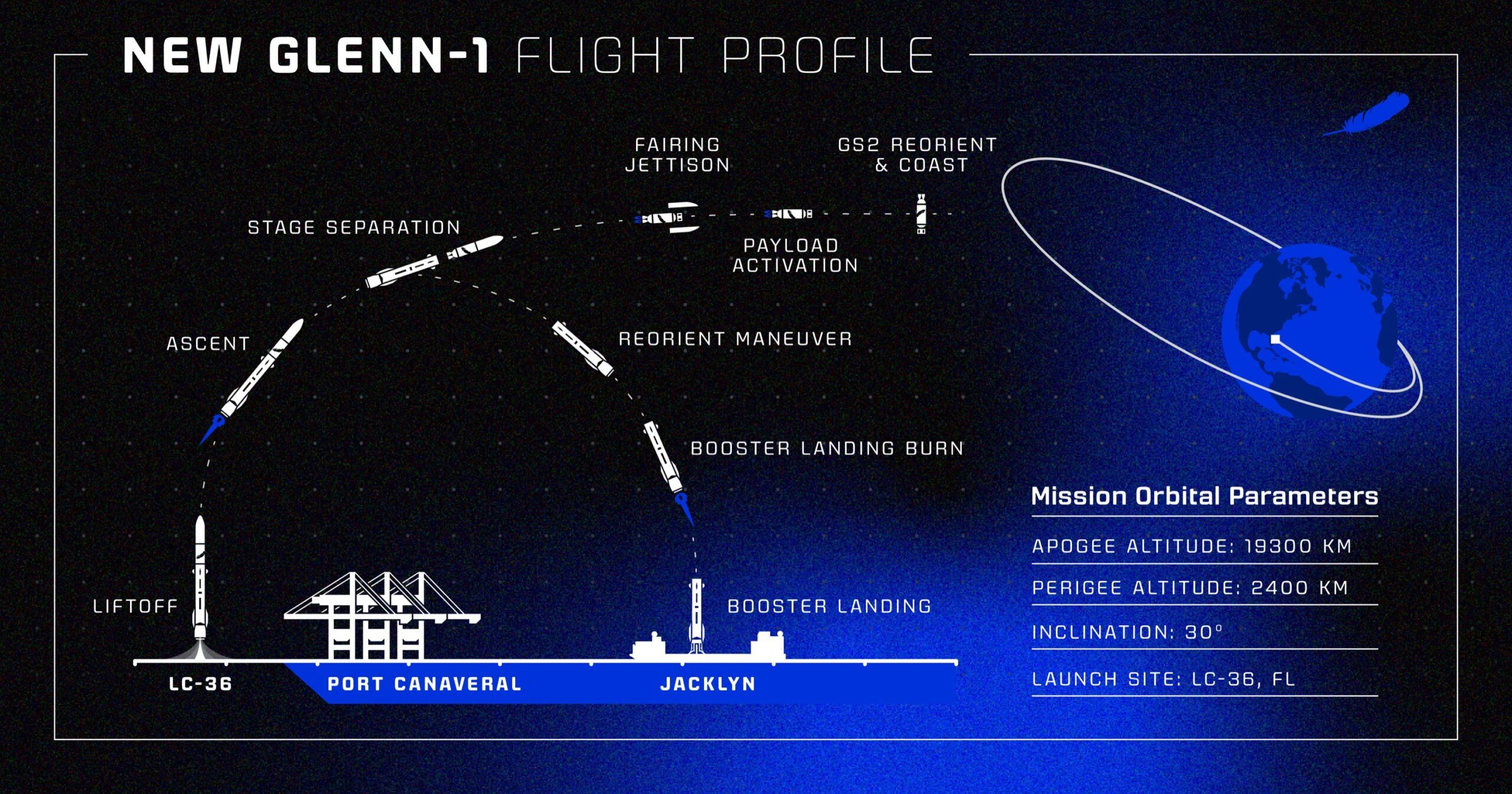
Mission profile for the first flight of the New Glenn rocket. Credit: Blue Origin
Since this is the debut flight of New Glenn, it is plausible that something could go wrong with the booster stage or upper stage in flight, although Blue Origin has gone to great effort to ensure a clean mission. Landing the first stage successfully on the initial flight represents a major challenge, however. Success seems unlikely, but not impossible.
"Our objective is to reach orbit," Blue Origin CEO Dave Limp said this week. "Anything beyond that is a bonus. Landing our booster offshore is ambitious—but we’re going for it. No matter what, we will learn a lot."
As for the second stage, it is intended to perform two burns within the first hour of the mission. The rocket is carrying a Blue Ring pathfinder, a demonstrator of the company's in-space vehicle that will provide power and last-mile services to future payloads.
Quelle: arsTechnica
----
Update: 16.01.2025
.
Blue Origin’s New Glenn Reaches Orbit
New Glenn safely reached its intended orbit during today's NG-1 mission, accomplishing our primary objective.
New Glenn’s seven BE-4 engines ignited on January 16, 2025, at 2:03 a.m. EST (0703 UTC) from Launch Complex 36 at Cape Canaveral Space Force Station.
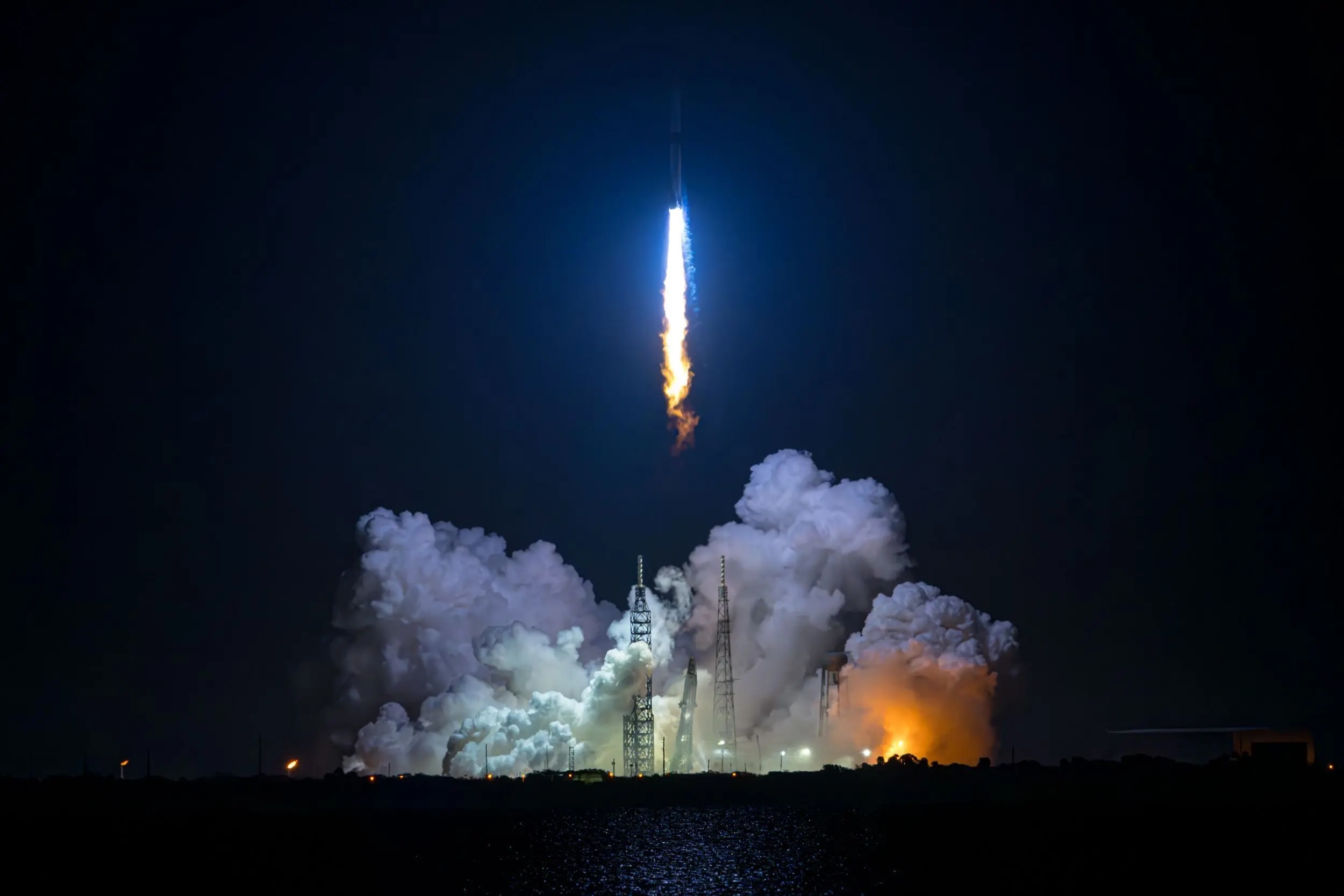
New Glenn at liftoff during the NG-1 mission (January 16, 2025).
The second stage is in its final orbit following two successful burns of the BE-3U engines. The Blue Ring Pathfinder is receiving data and performing well. We lost the booster during descent.
“I’m incredibly proud New Glenn achieved orbit on its first attempt,” said Dave Limp, CEO, Blue Origin. “We knew landing our booster, So You’re Telling Me There’s a Chance, on the first try was an ambitious goal. We’ll learn a lot from today and try again at our next launch this spring. Thank you to all of Team Blue for this incredible milestone.”
New Glenn is foundational to advancing our customers’ critical missions as well as our own. The vehicle underpins our efforts to establish sustained human presence on the Moon, harness in-space resources, provide multi-mission, multi-orbit mobility through Blue Ring, and establish destinations in low Earth orbit. Future New Glenn missions will carry the Blue Moon Mark 1 cargo lander and the Mark 2 crewed lander to the Moon as part of NASA’s Artemis program.
The program has several vehicles in production and multiple years of orders. Customers include NASA, Amazon’s Project Kuiper, AST SpaceMobile, and several telecommunications providers, among others. Blue Origin is certifying New Glenn with the U.S. Space Force for the National Security Space Launch (NSSL) program to meet emerging national security objectives.
"Today marks a new era for Blue Origin and for commercial space," said Jarrett Jones, Senior Vice President, New Glenn. "We're focused on ramping our launch cadence and manufacturing rates. My heartfelt thanks to everyone at Blue Origin for the tremendous amount of work in making today's success possible, and to our customers and the space community for their continuous support. We felt that immensely today."
January 15, 2025
The vehicle looks good for tonight’s window, but we’re watching weather closely as clouds build over the Space Coast. If we’re unable to launch, we’ll make an attempt on Friday, January 17, in the same 1-4 a.m. EST (0600-0900 UTC) window.
January 13, 2025
9:07 p.m. EST / 02:07 UTC
We’re moving our NG-1 launch to no earlier than Thursday, January 16. The three-hour launch window opens at 1 a.m. EST (0600 UTC).
6:50 p.m. EST / 23:50 UTC
Our next launch attempt is no earlier than Tuesday, January 14. Our three-hour launch window remains the same, opening at 1 a.m. EST (0600 UTC). Tonight’s poor weather forecast at LC-36 could result in missing this window. This morning’s scrub was due to ice forming in a purge line on an auxiliary power unit that powers some of our hydraulic systems.
3:09 a.m. EST / 08:09 UTC
We’re standing down on today’s launch attempt to troubleshoot a vehicle subsystem issue that will take us beyond our launch window. We’re reviewing opportunities for our next launch attempt.
January 12, 2025
New Glenn’s inaugural mission is targeting January 13. Our three-hour launch window opens Monday at 1 a.m. EST (0600 UTC).
Join us for the webcast hosted by Ariane Cornell and Denisse Aranda beginning an hour before launch: https://www.blueorigin.com/missions/ng-1
January 11, 2025
Sea state conditions are still unfavorable for booster landing. We're shifting our NG-1 launch date by one day to no earlier than January 13. Our three-hour window remains the same, opening Monday at 1 a.m. EST (0600 UTC).
January 9, 2025
We're shifting our NG-1 launch date to no earlier than January 12, due to a high sea state in the Atlantic where we hope to land our booster. Our three-hour window remains the same, opening Sunday at 1 a.m. EST (0600 UTC).
New Glenn Launch Targeting No Earlier Than January 10
January 6, 2025
New Glenn’s inaugural mission (NG-1) is targeting no earlier than Friday, January 10, from Launch Complex 36 at Cape Canaveral Space Force Station, Florida. The three-hour launch window opens at 1 a.m. EST (0600 UTC). NG-1 is our first National Security Space Launch certification flight.

The payload is our Blue Ring Pathfinder. It will test Blue Ring’s core flight, ground systems, and operational capabilities as part of the Defense Innovation Unit’s (DIU) Orbital Logistics prototype effort.
Our key objective is to reach orbit safely. We know landing the booster on our first try offshore in the Atlantic is ambitious—but we’re going for it.
“This is our first flight and we’ve prepared rigorously for it,” said Jarrett Jones, SVP, New Glenn. “But no amount of ground testing or mission simulations are a replacement for flying this rocket. It’s time to fly. No matter what happens, we’ll learn, refine, and apply that knowledge to our next launch.”
+++
